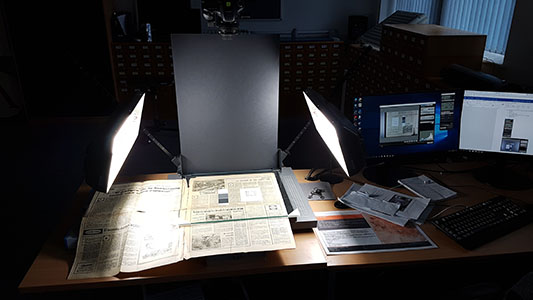June 13, 2019, by Matt Davies
The Hennessy Digitisation Project by Emily Parker
This week DTH Student Volunteer and History undergraduate Emily Parker tells us about her experiences working on our Hennessy Digitisation project. This project will be running again 2019 – 20, along with several new projects. If you are a Faculty of Arts student at the University of Nottingham and would like to find out more about volunteering in DTH please visit our webpage.
What is the Hennessy project?
Since January this year, volunteers from the Digital Transformations Hub have been working on digitising the Hennessy Collection. This is an archive of Cuban newspapers printed between 1960 and 1990, which Alistair Hennessy donated to the Forum for the Study of Cuba and are currently housed at the University of Nottingham. We are digitising issues of the newspaper ‘Granma’ to preserve them, as they are very fragile, and to make them accessible online.
How does the digitisation process work?
The digitisation process requires precision, as each photograph needs to be taken in exactly the same way and must be identifiable by its file name. We input the metadata of the photographs onto an Excel spreadsheet, to keep a clear record and cross reference the digitised newspapers.
The newspapers must be handled carefully with clean hands or gloves and placed under a glass screen, which helps to keep the pages flat when photographing them. A camera stand and lighting units are then used for taking photographs, which the volunteers are responsible for setting up. We also use Canon EOS Utility Software, which allows us to capture images remotely from the computer so that the camera can be kept still.
The next stage is editing the photographs in Photoshop. This consists of cropping, straightening, and adding pre-set colour settings to ensure that photos taken in often changing ambient light look the same. The photos are then saved with the correct file name and type (TIFF). As the newspapers are large, they have to be captured a half a page at a time, therefore the tops and bottoms of the pages have to be stitched together using Photoshop.
The volunteers on this project, along with those on the Djanogly Digitisation project, were taught the necessary handling and digitisation skills by experts from the University’s Manuscripts and Special Collections Team who ran a workshop in DTH exclusively for the volunteers on the projects at the start of term.
What are the benefits of volunteering with the DTH?
Faculty of Arts students volunteer for two hours per week, giving them the opportunity to learn and develop digital skills, which are increasingly important in the workplace. In my own case the Hennessy digitisation project has given me the opportunity to interact with physical primary documents outside of my History degree course, and to learn how they are handled and digitally preserved. I particularly recommend volunteering on the digitisation projects to anyone considering a career in heritage or archiving, as it is a fantastic way to get experience in these fields and is a valuable addition to your CV.
Find out more about the University’s Centre for Research on Cuba’s Hennessy Collection here.
No comments yet, fill out a comment to be the first


Leave a Reply